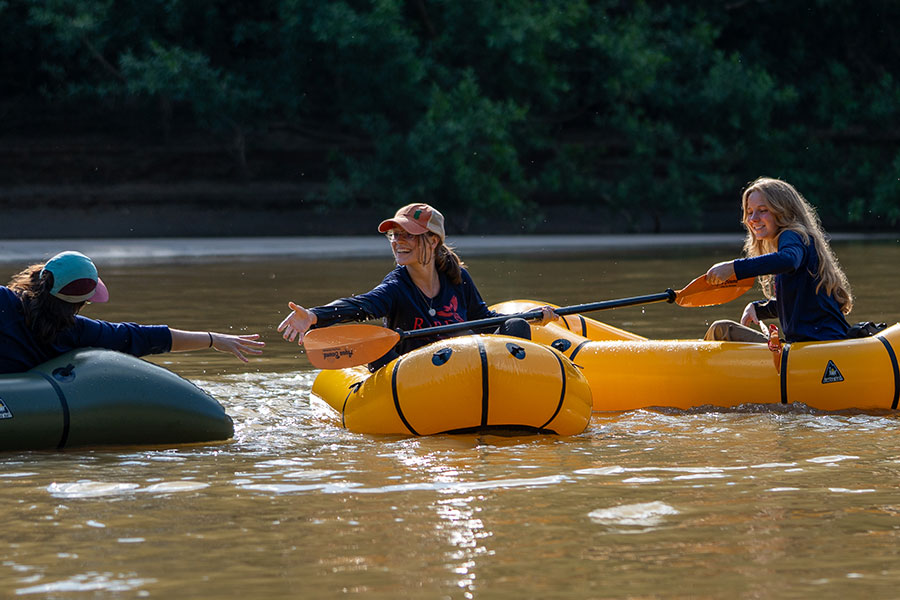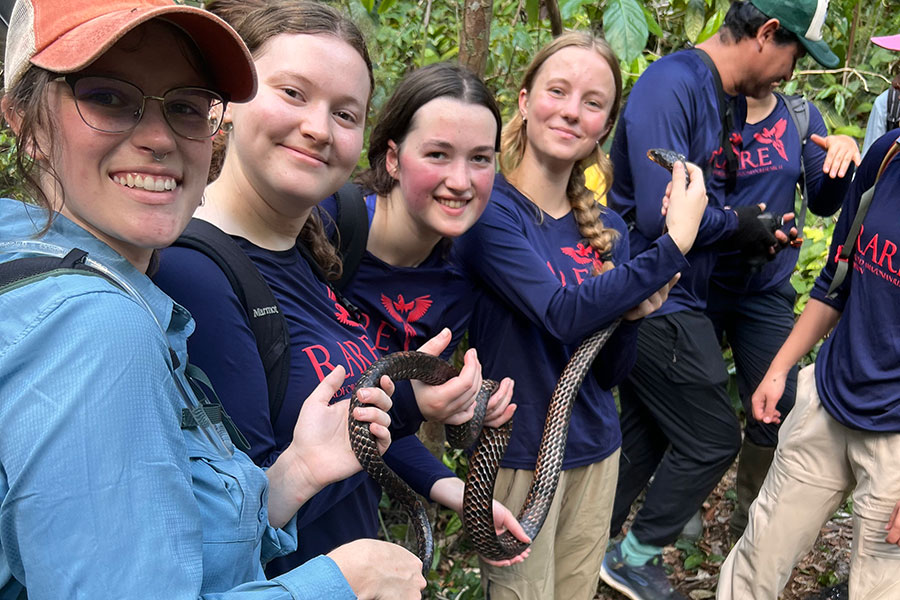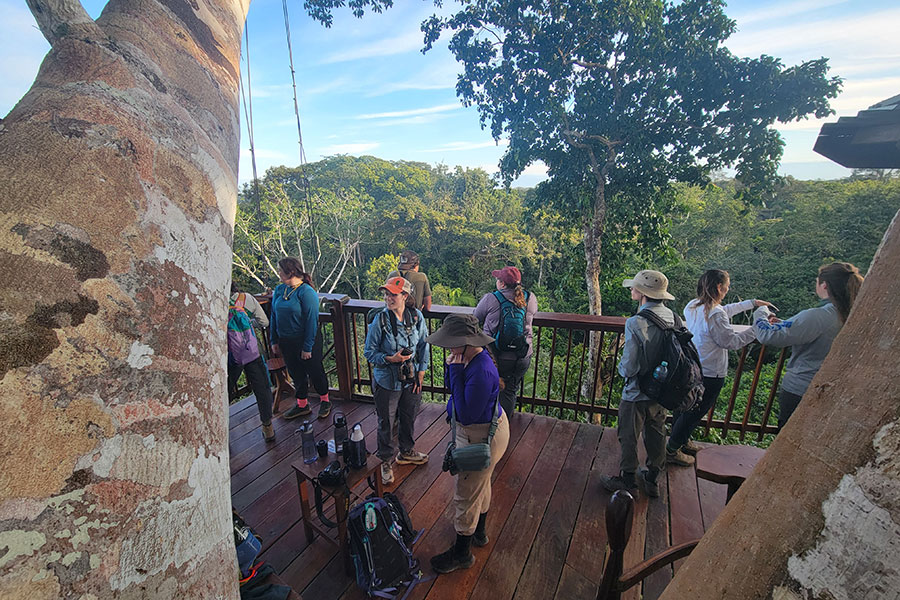
Sydney Johnson did things over the summer that she’d never have a chance to do in her Southwest Virginia hometown.
“Like pick up a giant scorpion and put it on my face,” she said, laughing, standing between two fellow student researchers inside a wooden structure, covered with a tin roof, at Estacion Loretillo, or Jungle Keeper Ranger Station, on the Las Piedras River in the Madre de Dios region of Peru.
Johnson, a Radford University junior from Wytheville, Virginia, was referring to the night hike she and about a dozen other Highlander researchers took through the Amazon jungle a few days earlier. They rode a boat a couple of miles down the river from their station and walked back.
“We were deep in the rainforest,” Johnson said, excited to tell the story. “There was a scorpion, a poison dart frog and a tarantula all in about 50 feet of each other.”
Along the walk, Jade Horton found the sand in the area a bit softer than she’s used to back home. “We fell in mud on the beach; you can sink several inches into the mud,” Horton said. “Ask me how I know.”
Johnson added to the story: “You don’t die, but it makes you feel like you might die, though,” she said before switching back to the giant scorpion story.
“It’s this crazy thing called a whip scorpion. We all put it on our faces. It doesn’t bite,” Johnson said, still smiling, recalling the experience and all she and her newfound friends had discovered on the three-week journey to the Amazon as part of the university’s Radford Amazonian Research Expedition (RARE). The annual trip provides undergraduate students with a unique opportunity to conduct original research in a primary Amazonian rainforest ecosystem.
Radford faculty members guide the student researchers through the expedition. Leading the way this year were associate professors of biology Tara Pelletier and Joyce Caughron and design instructor Camilla Morrison.

In Peru, students conduct their own original scientific studies or creative scholarship. Their laboratory is 30,000-plus acres of pristine rainforest along the Las Piedras River, which encompasses a wide variety of microbiomes and habitats. The students and faculty members reside at the research station.
“We’re outside 24/7,” Johnson said of the living quarters. “Even when you’re technically inside, you’re still outside.”
The group also had a chef who cooked two meals a day, “and they’re all amazing,” said Faith Ainslie, a junior biology major from Haymarket, Virginia. “We’ve had rice, chicken and plantain. Lots of plantain.” There were lots of juices, too, like papaya and corn.
“We’re eating things the people here eat,” Horton said.
Out in the field, Horton expanded on the research she began months earlier, exploring local people’s attitudes toward extractive industries in the Peruvian Amazon. Horton, a junior geospatial science major, spoke in Spanish with 16 local residents, asking their thoughts about those industries in the Peruvian Amazon.
“I’m going to use that data to write a paper about how extractive industries – agriculture, mining, logging, stuff like that – affect people and how they feel about it,” said Horton, who resides near Kingsport, Tennessee, and went to high school in Gate City, Virginia. “I want to see the difference between the attitudes around coal in Appalachia versus gold mining and logging in Peru.”
Johnson is studying stomata, pores for gas exchange, and in Peru, she retrieved samples from the legume family with plans to compare them with similar samples from Appalachia. “I love plants,” said the biology and recreation, parks and tourism double major, “so let’s see how plants here in the Amazon compare with those where we live.”
Ainslie spent her research time in Peru searching for feathers dropped from birds and examining them for mites. “The goal of the research,” she said, “is to compare the mite count on feathers found in the rainforest versus the nearby town and city.”

Student research on the RARE expedition focuses on a variety of topics related to the exploration of the jungle ecosystem. Past projects have examined the impact of deforestation on microbial metagenomics, analyzed the antibacterial and antifungal properties of rare plants, cataloged newly discovered species and tracked the behavior of megafauna, including tapir, jaguars, macaws and monkeys.
“It’s absolutely amazing what you can do here,” Johnson said. “It’s so awesome that Radford allows us to take this trip and grow as scientists. You can do whatever research you want. This has been such an amazing experience Radford has provided us.”
Part of the trip’s value, Horton noted, is the friendships students develop and the opportunities to learn about each other’s research. “I've gotten to help biochemists do their work,” she explained, “and learn from other scientists here who are doing things I had never done before.”
Students met some challenges along the way, more than the poison dart frogs, tarantulas and soft sands on night hikes.
“Sleeping under a bug net every night was really weird at first. The shower is about 8 degrees Fahrenheit. It’s freezing,” Johnson joked.
However, she continued, “If you have even the smallest inkling that you would want to do this, I would say, absolutely do it.”
Radford’s RARE Peru trip is “absolutely a once-in-a-lifetime experience,” Horton chimed in as the three spoke of their journey on what was a 70-degree July winter day south of the equator. “I've been challenged so many times on this trip, and I feel like it’s helped me grow so much as a person.”
Plus, Ainslie added, “It’s the jungle. It’s the Amazon. It’s just so cool to be here.”